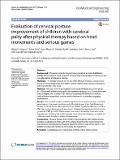Por favor, use este identificador para citar o enlazar a este item:
http://hdl.handle.net/10261/154435COMPARTIR / EXPORTAR:
 SHARE SHARE
 CORE
BASE CORE
BASE
|
|
| Visualizar otros formatos: MARC | Dublin Core | RDF | ORE | MODS | METS | DIDL | DATACITE | |

| Título: | Evaluation of cervical posture improvement of children with cerebral palsy after physical therapy based on head movements and serious games |
Autor: | Velasco, Miguel A. CSIC; Raya, Rafael CSIC ORCID; Muzzioli, Luca; Morelli, Daniela; Otero, Abraham; Iosa, Marco; Cincotti, Febo; Rocón, Eduardo CSIC ORCID | Palabras clave: | Cerebral palsy Cervical posture Inertial sensors Serious games |
Fecha de publicación: | 18-ago-2017 | Editor: | BioMed Central | Citación: | BioMedical Engineering OnLine 16(Suppl 1): 74 (2017) | Resumen: | [Background]
This paper presents the preliminary results of a novel rehabilitation therapy for cervical and trunk control of children with cerebral palsy (CP) based on serious videogames and physical exercise. [Materials] The therapy is based on the use of the ENLAZA Interface, a head mouse based on inertial technology that will be used to control a set of serious videogames with movements of the head. [Methods] Ten users with CP participated in the study. Whereas the control group (n = 5) followed traditional therapies, the experimental group (n = 5) complemented these therapies with a series of ten sessions of gaming with ENLAZA to exercise cervical flexion–extensions, rotations and inclinations in a controlled, engaging environment. [Results] The ten work sessions yielded improvements in head and trunk control that were higher in the experimental group for Visual Analogue Scale, Goal Attainment Scaling and Trunk Control Measurement Scale (TCMS). Significant differences (27% vs. 2% of percentage improvement) were found between the experimental and control groups for TCMS (p < 0.05). The kinematic assessment shows that there were some improvements in the active and the passive range of motion. However, no significant differences were found pre- and post-intervention. [Conclusions] Physical therapy that combines serious games with traditional rehabilitation could allow children with CP to achieve larger function improvements in the trunk and cervical regions. However, given the limited scope of this trial (n = 10) additional studies are needed to corroborate this hypothesis. |
Versión del editor: | http://dx.doi.org/10.1186/s12938-017-0364-5 | URI: | http://hdl.handle.net/10261/154435 | DOI: | 10.1186/s12938-017-0364-5 | ISSN: | 1475-925X |
| Aparece en las colecciones: | (CAR) Artículos |
Ficheros en este ítem:
| Fichero | Descripción | Tamaño | Formato | |
|---|---|---|---|---|
| Evaluation_cervical_posture_improvement.pdf | 1,16 MB | Adobe PDF |  Visualizar/Abrir |
CORE Recommender
PubMed Central
Citations
13
checked on 08-abr-2024
SCOPUSTM
Citations
30
checked on 16-abr-2024
WEB OF SCIENCETM
Citations
24
checked on 27-feb-2024
Page view(s)
344
checked on 19-abr-2024
Download(s)
324
checked on 19-abr-2024

